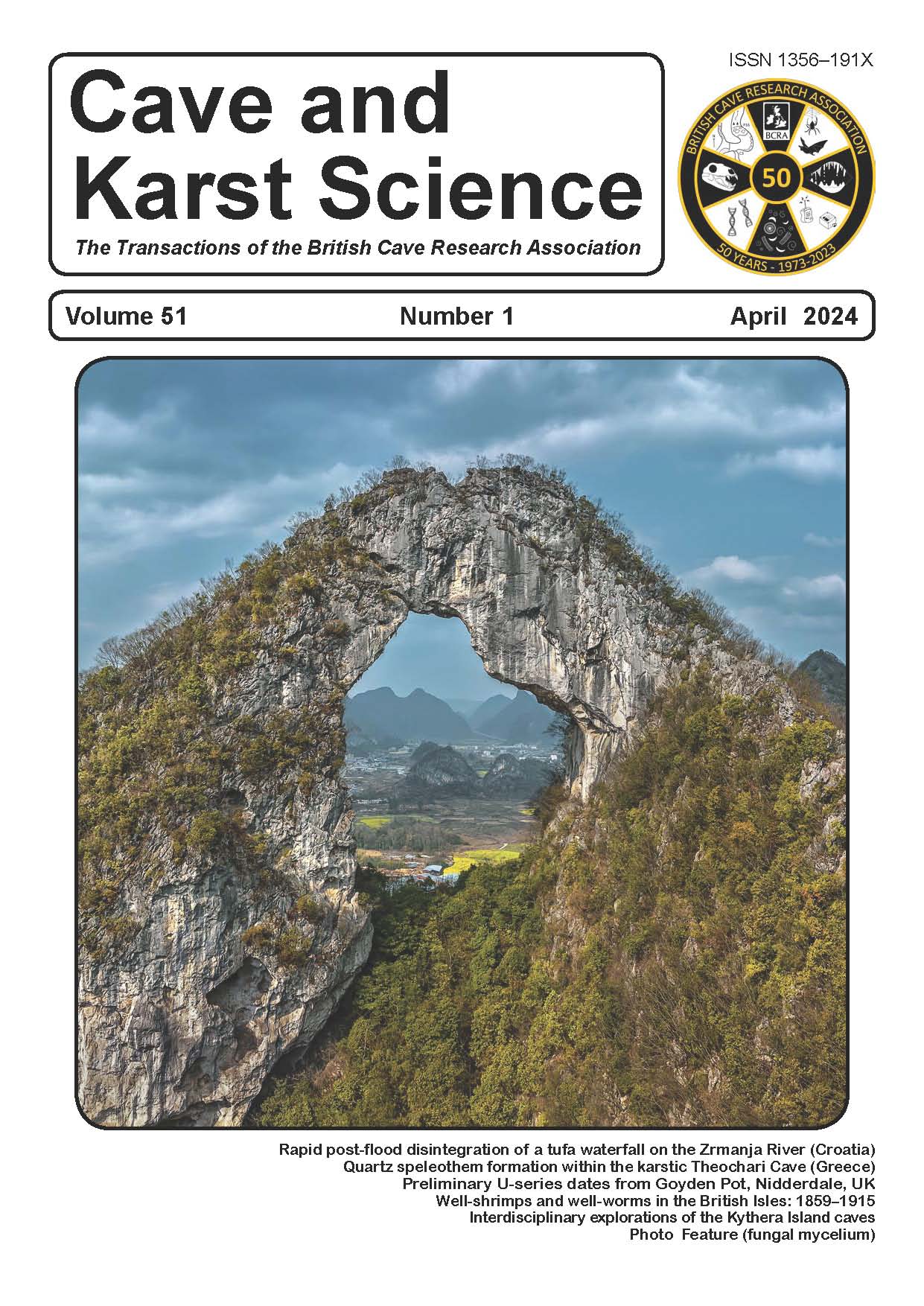
The latest edition of the BCRA’s Cave and Karst Science contains five main papers, and a photo feature. It begins, however, with tributes to David St. Pierre, John Wilcock and David William Gill.
The editors write that, yet again, it is their sad privilege to introduce and present words of tribute and celebration dedicated to friends and colleagues who have been lost both to caving and to the world of cave and karst science.
Max Moseley writes that the understanding of British subterranean aquatic fauna hardly advanced in the half century before the First World War. The ecological and physical continuity between groundwaters and caves was only dimly perceived, and they were dealt with separately in practice. In the case of groundwater fauna interest was confined to blind forms from wells and pumps. The mind-set was predominantly local and insular. When an authoritative key work detailing the known occurrence and taxonomy of Britain’s native well-shrimps was published in 1862, the British Isles had been the earliest and most prolific source of new species. However, by 1914 little more had been published about them or about other groundwater fauna, whereas the science of phreatobiology had been established firmly in continental Europe. The reasons cannot be ascribed simplistically to the relative impoverishment of Britain’s subterranean fauna, which was not yet really apparent, and instead it is argued, they lie elsewhere. The sociology and organization of ‘amateur’ and professional natural history of the period were not conducive. Such collecting as was done was driven more by water sanitation concerns that can be traced back to the cholera epidemics in mid-century than to zoological interest. The outbreak of war not only terminated this chapter of Britain’s speleobiological history abruptly, but also led to most of what had been recorded being overlooked for decades.
Konstantinos Trimmis and his co-workers report on the Cerigo Speleological Project 2009-12 which carried out interdisciplinary exploration of the caves of Kythera Island. This work was organized with the aim of recording and studying the many cave-forms on the Island. The approach included elements from the many different fields of cave science. Four expeditions between 2009–2012 recorded 64 cave-forms. During the field research, valuable observations were made within the fields of geology, biology, and local cultural history.
Phil Murphy, Xie Kang, Gina Moseley and Chris Fox present preliminary U-series dates from Goyden Pot as they work towards producing a chronology for the caves of Nidderdale, North Yorkshire, UK. The Manchester Hole/Goyden Pot/Nidd Heads cave system has developed beneath a cover of clastic strata with only limited limestone at outcrop, occurring as inliers in the valley bottom. U-series dates obtained from speleothem samples collected in Goyden Pot show that cave development occurred prior to Marine Isotope Stage 3. The presence of detrital thorium in the speleothem samples, probably due to the nature of the catchment, limits dating precision. However, this study confirms that there is a long history of karstification in the area.
Georgios Lazaridis, Lambrini Papadopoulou, Vasilios Melfos, Kantiranis Nikolaos and Panagiotis Voudouris have been investigating the formation of quartz speleothems within the karstic Theochari Cave in Greece. Their study investigates the origin of quartz speleothems, using SEM-EDS and XRPD analyses. The presence of quartz is rarely reported in karstic caves formed in carbonate rocks. Geological and morphological features of the cave were examined, identifying the coexistence of quartz and calcite in speleothems. Analyses of cave morphology and mineralogy, augmented by consideration of previous studies, allow proposal of a sequence of events in the cave’s history, suggesting that hydrothermal processes probably contributed to quartz formation. Biosignatures were notably absent. The findings shed light on the development and history of quartz speleothems in Theochari Cave, inviting more-detailed research into the geological processes that are involved.
Ivan Marić, Fran Domazetović and Rina Milošević looked at the rapid post-flood disintegration of a tufa waterfall on the Zrmanja River in Croatia. Calcareous tufa is a porous deposit formed along river channels by interactions between ambient precipitation of calcium carbonate (CaCO3) and organisms. The Zrmanja River is recognized as one of the most beautiful in Croatia, flowing through a rough karst landscape with many waterfalls. In this paper, the recent post-flood disintegration of the tufa waterfall known as Visoki buk has been analysed. With an average height of 9m and width of about 50m, Visoki buk is the largest and highest tufa waterfall on the Zrmanja River. The cause of the tufa waterfall collapse and retreat was shown to be linked to extremely high discharges during a torrential flood event in May 2023. The quantification was carried out using an Unmanned Aerial Vehicle (UAV) survey (2023), Google Earth historical imagery (2013) and a handheld Artec Eva 3D scanner. Based on a comparison of pre-flood and post-flood data, it was calculated that the areal surface of the collapsed waterfall amounts to 330m². The maximum retreat distance of the tufa barrier was 10.2m, while the average retreat was 6.3m. Tufa formation dynamics and changes in the flow-rate fluctuation in the Zrmanja should be viewed as a natural process, where the large remnant blocks and enormous boulders of collapsed tufa will become nuclei on which tufa-forming organisms will establish and, eventually, tufa will emerge.
The issue closes with a photo feature by Vince Simmonds illustrating fungal mycelium in Swan Mine, Bath and Northeast Somerset, UK.
Finally, it is worth pointing out that the editorial in this issue states that future access to the online version of Cave and Karst Science is to be wholly open, at no cost to authors and with no requirement for readers to either join BCRA or to register. This move is warmly welcomed by your reviewer. The change is ongoing and details may be found here. Cave and Karst Science is published three times a year. The publication contains a wealth of information and represents excellent value for money for anyone with an interest in the science of caves. It is well-presented throughout, with a clear, attractive layout and numerous high-quality illustrations.
